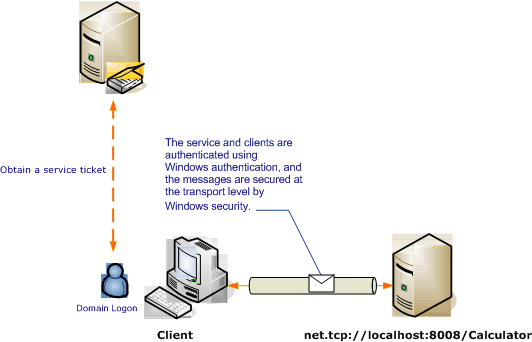Transportsicherheit mit Windows-Authentifizierung
Das folgende Szenario zeigt einen Client und einen Dienst von Windows Communication Foundation (WCF), die durch Windows-Sicherheit gesichert sind. Weitere Informationen zur Programmierung finden Sie unter Vorgehensweise: Sichern eines Diensts mit Windows-Anmeldeinformationen.
Ein Intranetwebdienst zeigt Personalinformationen an. Der Client ist eine Windows Forms-Anwendung. Die Anwendung wird in einer Domäne mit einem Kerberos-Controller bereitgestellt, der die Domäne sichert.

| Merkmal | Beschreibung |
|---|---|
| Sicherheitsmodus | Transport |
| Interoperabilität | Nur WCF |
| Authentifizierung (Server) Authentifizierung (Client) |
Ja (mithilfe der integrierten Windows-Authentifizierung) Ja (mithilfe der integrierten Windows-Authentifizierung) |
| Integrität | Ja |
| Vertraulichkeit | Ja |
| Transport | NET.TCP |
| Bindung | NetTcpBinding |
Dienst
Der folgende Code und die folgende Konfiguration werden unabhängig voneinander ausgeführt. Führen Sie eines der folgenden Verfahren aus:
Erstellen Sie einen separaten Dienst, indem Sie den Code ohne Konfiguration verwenden.
Erstellen Sie mit der angegebenen Konfiguration einen Dienst, aber definieren Sie keine Endpunkte.
Code
Im folgenden Code wird gezeigt, wie ein Dienstendpunkt, der Windows-Sicherheit verwendet, erstellt wird.
// Create the binding.
NetTcpBinding binding = new NetTcpBinding();
binding.Security.Mode = SecurityMode.Transport;
binding.Security.Transport.ClientCredentialType =
TcpClientCredentialType.Windows;
// Create the URI for the endpoint.
Uri netTcpUri = new Uri("net.tcp://localhost:8008/Calculator");
// Create the service host and add an endpoint.
ServiceHost myServiceHost = new ServiceHost(typeof(Calculator), netTcpUri);
myServiceHost.AddServiceEndpoint(typeof(ServiceModel.ICalculator), binding, "");
// Open the service.
myServiceHost.Open();
Console.WriteLine("Listening...");
Console.ReadLine();
// Close the service.
myServiceHost.Close();
' Create the binding.
Dim binding As New NetTcpBinding()
binding.Security.Mode = SecurityMode.Transport
binding.Security.Transport.ClientCredentialType = TcpClientCredentialType.Windows
' Create the URI for the endpoint.
Dim netTcpUri As New Uri("net.tcp://localhost:8008/Calculator")
' Create the service host and add an endpoint.
Dim myServiceHost As New ServiceHost(GetType(ServiceModel.Calculator), netTcpUri)
myServiceHost.AddServiceEndpoint(GetType(ServiceModel.ICalculator), binding, "")
' Open the service.
myServiceHost.Open()
Console.WriteLine("Listening...")
Console.ReadLine()
' Close the service.
myServiceHost.Close()
Konfiguration
Die folgende Konfiguration kann statt des Codes verwendet werden, um den Dienstendpunkt einzurichten:
<?xml version="1.0" encoding="utf-8"?>
<configuration>
<system.serviceModel>
<behaviors />
<services>
<service behaviorConfiguration="" name="ServiceModel.Calculator">
<endpoint address="net.tcp://localhost:8008/Calculator"
binding="netTcpBinding"
bindingConfiguration="WindowsClientOverTcp"
name="WindowsClientOverTcp"
contract="ServiceModel.ICalculator" />
</service>
</services>
<bindings>
<netTcpBinding>
<binding name="WindowsClientOverTcp">
<security mode="Transport">
<transport clientCredentialType="Windows" />
</security>
</binding>
</netTcpBinding>
</bindings>
<client />
</system.serviceModel>
</configuration>
Client
Der folgende Code und die folgende Konfiguration werden unabhängig voneinander ausgeführt. Führen Sie eines der folgenden Verfahren aus:
Erstellen Sie mit dem Code (und Clientcode) einen eigenständigen Client.
Erstellen Sie einen Client, der keine Endpunktadressen definiert. Verwenden Sie stattdessen den Clientkonstruktor, der den Konfigurationsnamen als Argument verwendet. Zum Beispiel:
CalculatorClient cc = new CalculatorClient("EndpointConfigurationName");Dim cc As New CalculatorClient("EndpointConfigurationName")
Code
Der folgende Code erstellt den Client. Die Bindung ist für die Verwendung der Transportmodussicherheit mit dem TCP-Transport konfiguriert, wobei der Clientanmeldeinformationstyp auf Windows festgelegt ist.
// Create the binding.
NetTcpBinding myBinding = new NetTcpBinding();
myBinding.Security.Mode = SecurityMode.Transport;
myBinding.Security.Transport.ClientCredentialType =
TcpClientCredentialType.Windows;
// Create the endpoint address.
EndpointAddress myEndpointAddress = new
EndpointAddress("net.tcp://localhost:8008/Calculator");
// Create the client. The code for the calculator client
// is not shown here. See the sample applications
// for examples of the calculator code.
CalculatorClient cc =
new CalculatorClient(myBinding, myEndpointAddress);
try
{
cc.Open();
// Begin using the client.
Console.WriteLine(cc.Add(100, 11));
Console.ReadLine();
// Close the client.
cc.Close();
}
' Create the binding.
Dim myBinding As New NetTcpBinding()
myBinding.Security.Mode = SecurityMode.Transport
myBinding.Security.Transport.ClientCredentialType = TcpClientCredentialType.Windows
' Create the endpoint address.
Dim myEndpointAddress As New EndpointAddress("net.tcp://localhost:8008/Calculator")
' Create the client. The code for the calculator client
' is not shown here. See the sample applications
' for examples of the calculator code.
Dim cc As New CalculatorClient(myBinding, myEndpointAddress)
cc.Open()
' Begin using the client.
Try
cc.Open()
Console.WriteLine(cc.Add(100, 11))
Console.ReadLine()
' Close the client.
cc.Close()
Catch tex As TimeoutException
Console.WriteLine(tex.Message)
cc.Abort()
Catch cex As CommunicationException
Console.WriteLine(cex.Message)
cc.Abort()
Finally
Console.WriteLine("Closed the client")
Console.ReadLine()
End Try
Konfiguration
Die folgende Konfiguration kann statt des Codes verwendet werden, um den Client zu erstellen.
<?xml version="1.0" encoding="utf-8"?>
<configuration>
<system.serviceModel>
<bindings>
<netTcpBinding>
<binding name="NetTcpBinding_ICalculator" >
<security mode="Transport">
<transport clientCredentialType="Windows" />
</security>
</binding>
</netTcpBinding>
</bindings>
<client>
<endpoint address="net.tcp://localhost:8008/Calculator"
binding="netTcpBinding"
bindingConfiguration="NetTcpBinding_ICalculator"
contract="ICalculator"
name="NetTcpBinding_ICalculator">
</endpoint>
</client>
</system.serviceModel>
</configuration>